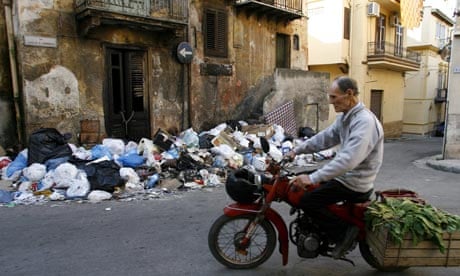Paolo Giacomelli, deputy mayor of Naples in charge of the environment, sometimes wakes up at night to check the level of the bins outside his building. "An emergency," he says, "can happen any time."
About two weeks ago a 24-hour strike by dustmen brought back memories of the 2008 crisis when the stench of uncollected waste filled the city. Piles of trash accumulated in the town centre and suburbs, attracting hordes of flies and media. "After one day's strike, it takes me three days to straighten things out," says an exhausted Giacomelli.
Why after 20 years is Naples still in this mess? The Italian prime minister, Silvio Berlusconi, keeps saying the problem – a key priority in his 2008 election campaign – has been settled.
"For everything to work normally," Giacomelli patiently explains, "three conditions need to be met. We need space in the dumps, an incinerator running at full power, and greater capacity for selective recycling. But we are not there yet."
All the dumps in the vicinity of Naples are full or almost full. Plans for a new facility, with room for 10m tonnes of rubbish, at Terzigno in the Mount Vesuvius national park, have run into fierce opposition from local residents. Dustcarts were torched and on 10 October 3,000 people burned their voting cards in protest.
Luigi Casciello, a retired station master, heads the residents' resistance movement. "We are living in one of the most polluted places in Europe, with very high cancer rates among the population," he says. "Why should we have to find room for more incinerators and dumps? Why is everything recycled in Treviso [in northern Italy], and nothing here?"
Giacomelli says: "In 2008 almost 20% of waste was selectively recycled. We have not been able to improve on that for lack of funds. We nevertheless remove 200 tonnes of waste a day for recycling. But there isn't a single composting facility in the region. We have to send it all to Sicily, which costs [$280] a tonne."
As for the incinerators, four were originally planned but only one, in Acera, has been completed. It was commissioned by Berlusconi in April 2009. Specified to incinerate 600,000 tonnes of waste a year, the unit only works intermittently. Only one of the four furnaces is operational. The public prosecutor in Naples has just opened an inquiry to check that the facility meets its specifications, both in terms of emissions and throughput.
This state of affairs has brought warnings from the European Union, which is funding measures to bring waste collection and processing up to standard. On a recent visit to Brussels a councillor caused a stir when he admitted it would take another 20 years to achieve "a normal situation". Since then $560m in subsidies have been frozen.
The only people to benefit from the confusion and wasted public money are the Camorra, Campania's mafia. Organised crime has infiltrated much of the waste business – aided and abetted by corrupt politicians – from collection to processing through transport. Things have gone so far that the city council has stopped putting the relevant contracts out to tender. All the city's transport contractors now get a share of the market.
Berlusconi plans to visit Naples soon. He still expects opponents of the new tips to lose interest and the finance ministry to release the necessary funds, throwing more money at a problem that has swallowed billions.
This article originally appeared in Le Monde
